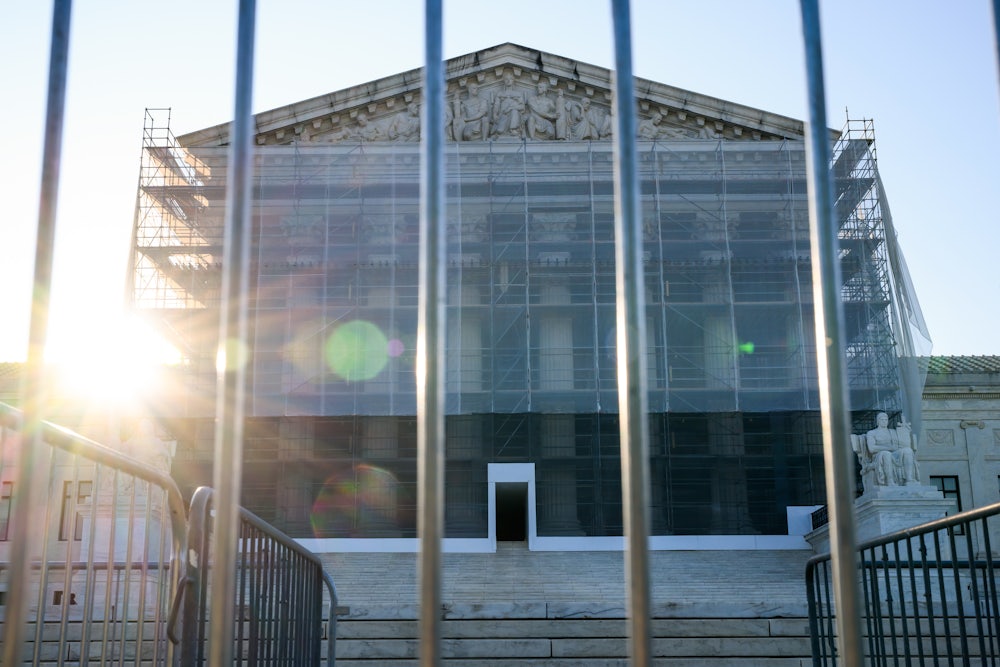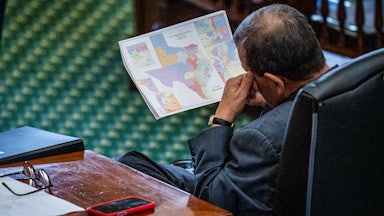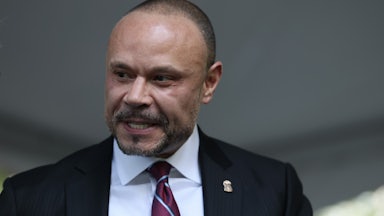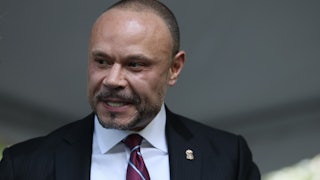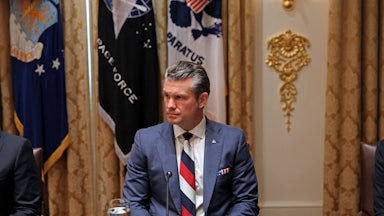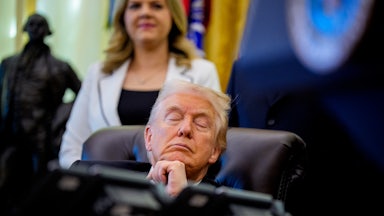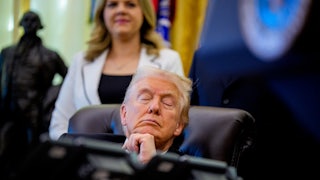The Supreme Court dealt a severe blow to the American rule of law on Monday night by clearing the way for the Trump administration to deport migrants and other noncitizens to random countries where they have no ties or connections, effectively rewarding the White House for its defiance of court orders to the contrary.
Federal judges in the lower courts had previously blocked the administration from carrying out such removals by citing the Fifth Amendment’s due process clause. The plaintiffs and the courts cited evidence that the government had provided little to no notice to noncitizens facing such removal and had ignored federal law that gives them an opportunity to challenge it. To make matters worse, the administration continued to carry out the removals even after a court order barred them from doing so.
Without any explanation, however, the high court sided with the Trump administration and stayed the lower court orders until further notice, in a 6–3 decision. The conservative majority’s intervention will allow the administration to carry out further removals to countries like Libya and South Sudan, despite the ongoing legal challenges—and despite the White House’s own misconduct.
“Rather than allowing our lower court colleagues to manage this high-stakes litigation with the care and attention it plainly requires, this court now intervenes to grant the government emergency relief from an order it has repeatedly defied,” Justice Sonia Sotomayor wrote in a dissenting opinion, which was joined by the court’s other two liberals. “I cannot join so gross an abuse of the court’s equitable discretion.”
Department of Homeland Security v. DVD involves a group of migrants facing removal from the United States by the Trump administration. (DVD is the abbreviated name of one of the anonymized plaintiffs.) Federal law lays out the hierarchy of countries to which someone can be deported from the United States. It starts with the country from which they originally arrived. Then, if that country is not feasible, the list goes through nearest alternatives like their birth country, where they hold citizenship, and so on.
What happens if none of those places are feasible? Only then can the government conduct what is known as a third-country removal, where they effectively send the noncitizen to a country where they have no relevant ties or connections. This is an extraordinary step, and federal law only allows it after exhausting every other option. In the 1990s, Congress also incorporated portions of an anti-torture treaty to forbid the executive branch from sending someone to a country where they would likely face torture or similar degrading treatment. Anyone facing removal is entitled to challenge it on those grounds.
The Trump administration does not really care about any of this. Its goal is to remove as many noncitizens from the country as possible. It wants to carry out that mission as quickly as possible and as easily as possible, and it has chafed at the legal and constitutional constraints that stand in its way. Among the plaintiffs in this case, for example, is a gay Guatemalan man who had been illegally deported by the Department of Homeland Security to Mexico, where he had been previously raped, before the Trump administration returned him to the United States after his lawyers asked the court to intervene.
The plaintiffs asked a federal judge in Massachusetts to block DHS from carrying out further third-country removals unless it provided appropriate notice—in the Guatelaman man’s case, DHS only informed of his removal to Mexico after he had been placed on the bus there—and gave the migrants a “meaningful” chance to challenge that removal on the grounds that they could face a credible risk of torture or mistreatment. The judge granted their request and imposed a temporary restraining order, or TRO, on those grounds while legal proceedings continued.
As expected, the Trump administration appealed the TRO to the First Circuit Court of Appeals, which is considering its merits. It also asked the Supreme Court to lift the TRO while litigation is ongoing. At the same time, the administration also took aggressive steps to circumvent and defy the order. The Guatemalan man and three other named plaintiffs were flown to a prison in El Salvador, where the Salvadoran government is holding them at the Trump administration’s request. Federal judges later blocked further removals to CECOT, but DHS refused to turn around planes that were already in the air.
In May and June, the government also removed nearly two dozen other migrants who were allegedly covered by the TRO to third countries like Libya and South Sudan, only for federal courts to intervene there as well after their lawyers caught wind of the plans. “Short of the noncitizens ‘yelling at any of the jailers that they were afraid to go to South Sudan’ (as the district court put it), DHS did not offer the noncitizens an opportunity to assert a claim under the Convention [Against Torture],” Sotomayor noted in her dissent.
They had good reason to be afraid. Libya has been governed by two rival provisional governments since a civil war after the collapse of Muammar Qaddafi’s regime more than a decade ago. While active warfare has largely ended since a 2020 ceasefire, there are still occasional bouts of violence and unrest. South Sudan, the world’s newest country, has struggled with famine, civil war, and armed ethnic conflicts since it became fully independent in 2011.
To understand the full impact of this case, it is important to know the precise question that the Supreme Court was answering in it. When a federal district court judge issues a temporary restraining order in any litigation, the Supreme Court weighs multiple factors when deciding whether it would be appropriate. One of them is whether a TRO would prevent “irreparable harm” to one side. That prevents one side from mooting the case by taking irreversible steps that a court could not later remedy. Another factor is whether the plaintiffs are “likely to succeed” on the merits. That prevents the courts from acting frivolously or unnecessarily.
The default assumption, at least according to the Supreme Court’s own precedents, is that the justices will rarely grant a stay out of deference to the lower courts. Sotomayor argued that the government had not done so here, even though the court failed both of those tests. On the irreparable harm question, she noted that the Trump administration had made the “facially absurd contention” that it is harmed “any time a court orders it temporarily to refrain from doing something it would like to do.”
That is apparently enough to suffice, however, since Sotomayor’s colleagues in the majority “[appear] to give no serious consideration to the irreparable harm factor” in Trump-related shadow docket cases these days, she said. If anything, Sotomayor pointed out, it is the plaintiffs and those like them who face irreparable harm here if they are sent to a strange country on a different continent that lacks the rule of law and suffers from endemic violence.
On the likelihood-of-success question, Sotomayor had even greater contempt for the Trump administration’s arguments. “Given its conduct in these proceedings, the government’s posture resembles that of the arsonist who calls 911 to report firefighters for violating a local noise ordinance,” she wrote. Indeed, she noted, courts are supposed to decline to intervene like this in cases under the “clean hands” doctrine, which counsels courts to deny this kind of relief to litigants who don’t act in good faith.
“The government thus openly flouted two court orders, including the one from which it now seeks relief. Even if the orders in question had been mistaken, the government had a duty to obey them until they were ‘reversed by orderly and proper proceedings,’” Sotomayor explained, quoting from precedent. “That principle is a bedrock of the rule of law. The government’s misconduct threatens it to its core.”
Sotomayor’s version of events is persuasive. (It is among her strongest dissents I can recall.) If the Supreme Court’s conservative majority has any counterarguments, it did not offer them. Shadow docket cases like this one are supposed to be ones in which time is of the essence, so the majority is not required to explain its reasoning in a written opinion. That may be understandable when the court is dealing with, say, frivolous requests for intervention where explanation is not warranted or ticking-clock petitions in death-penalty cases where it would be counterproductive. It is less conscionable when the court is effectively nullifying U.S. treaty obligations and the provisions in federal law that incorporate them.
In some cases, a justice from the majority will attach a concurring opinion to further explain their approach to the case, but none of the six in the majority did so here. They had ample opportunity: Briefing was completed on June 5, and the court did not issue its order until June 23. (That delay alone disproves the administration’s claims that emergency relief was necessary.) Even though June is the court’s busiest month, Sotomayor still found the time to write a powerful 19-page dissent. The court instead overrode its colleagues in the lower courts by pure fiat.
This is not how things are supposed to work. Under the Constitution, federal courts have neither the power of the purse nor the power of the sword. The judicial power instead rests the power of reason—or, more bluntly, on the public confidence that they are correctly interpreting the law. Courts bolster that power by explaining their decisions in writing, by explaining how they reached their conclusions, and by proving to Americans that they are acting in accordance with law and precedent.
The Supreme Court’s habit of effectively resolving major cases on the shadow docket with little or no explanation is not new, nor has it gone uncriticized by legal scholars or court watchers. Monday’s ruling is nonetheless a major escalation in its approach. Using these types of cases to reward presidential lawlessness without even the pretense of an explanation is a dangerous frontier for the conservative justices. It contributes to the growing public perception that their rulings are arbitrary and partisan.
“This is not the first time the court closes its eyes to noncompliance, nor, I fear, will it be the last,” Sotomayor warned. “Yet each time this court rewards noncompliance with discretionary relief, it further erodes respect for courts and for the rule of law.” Even if the justices think they are staving off further institutional damage by avoiding direct conflict with the Trump administration, that strategy can only backfire. Not only would it show that the court cannot decide high-stakes cases without fear or favor, it would only encourage future presidents to adopt similar tactics to receive similar concessions. If the court has thought through its current course of action, then it has not shown its work.
